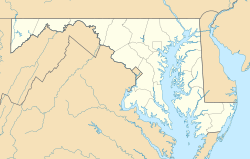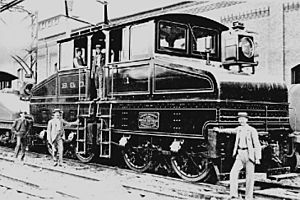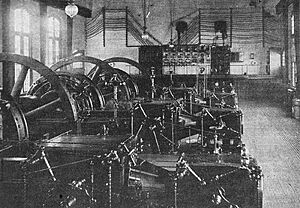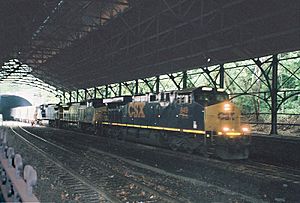Baltimore Belt Line facts for kids
Quick facts for kids Baltimore Belt Line |
|
|---|---|
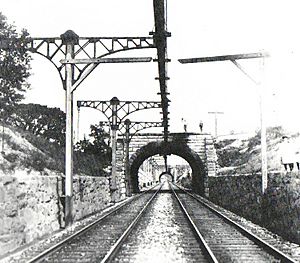
B&O's overhead third-rail system at Guilford Avenue in Baltimore, 1901, part of the Baltimore Belt Line. The central position of the overhead conductors was dictated by the many tunnels on the line: the ∩-shaped rails were located at the highest point in the roof to give the most clearance
|
|
| Overview | |
| Status | Operational |
| Owner | Baltimore and Ohio Railroad (Original) CSX Transportation (Current) |
| Locale | Baltimore, Maryland, United States |
| History | |
| Electrified via overhead rail | 1895 |
| Electrification removed | 1952 |
| Technical | |
| Track gauge | 4 ft 8 1⁄2 in (1,435 mm) standard gauge |
| Electrification | formerly electrified |
The Baltimore Belt Line is a special railway line in Baltimore, Maryland. It was built by the Baltimore and Ohio Railroad (B&O) in the 1890s. Its main job was to connect B&O trains coming from Philadelphia and New York City to the rest of the B&O railway network in Baltimore.
This important line includes the long Howard Street Tunnel and the beautiful Mount Royal Station. It was also the first major railroad in the United States to use electricity to power its trains! Today, CSX Transportation operates this busy railway line.
Contents
Why the Belt Line Was Built
Before the Belt Line, B&O trains in Baltimore used horses to pull cars through city streets. This was because steam locomotives were not allowed in the city center. Trains would travel between the B&O's Camden Station and the President Street Station of another railroad, the Philadelphia, Wilmington and Baltimore Railroad (PW&B).
In 1884, a rival company, the Pennsylvania Railroad (PRR), bought the PW&B. This meant the B&O could no longer use that connection. So, the B&O decided to build its own new line to Philadelphia and New York.
However, this new line needed a way to connect to the rest of the B&O system in Baltimore. Building a new track through the busy city streets was too hard and expensive. Going around the city would have meant building many bridges and changing the land a lot.
So, the B&O came up with a bold plan: build a series of tunnels right under the city! This challenging project was led by a young engineer named Samuel Rea.
Building the Line
The chosen route started at Camden Station. From there, a long tunnel was dug directly under Howard Street. This tunnel went north through the city.
At the north end of the tunnel, the impressive Mount Royal Station was built between 1891 and 1896. After the station, the tracks curved east. They passed through six more tunnels, though these were much shorter.
The line continued around the northern and eastern parts of downtown. Finally, it turned southeast to connect with the already built line near the Canton neighborhood. This completed the B&O's new East Coast route.
The construction was very expensive. It cost so much that the Baltimore & Ohio Railroad went into bankruptcy shortly after the line opened in 1895.
Howard Street Tunnel
|
Howard Street Tunnel
|
|||||||||||
|---|---|---|---|---|---|---|---|---|---|---|---|
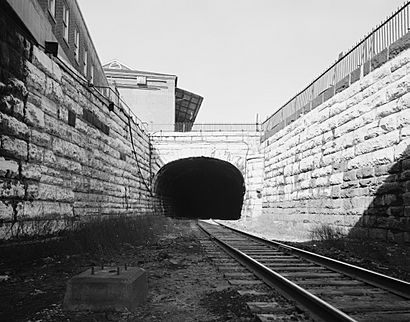
Howard Street Tunnel
|
|||||||||||
| Coordinates | 39°18′17″N 76°37′15″W / 39.30472°N 76.62083°W | ||||||||||
| Line(s) | Baltimore Terminal Subdivision | ||||||||||
| Connections | Camden Street Station | ||||||||||
| History | |||||||||||
| Closed | 1958 (renovated 1967 for Maryland Institute College of Art) | ||||||||||
| Former services | |||||||||||
|
|||||||||||
|
Howard Street Tunnel
|
|||||||||||
| Location | Beneath Howard St. from Mt. Royal Station to Camden Station, Baltimore, Maryland | ||||||||||
| Area | 3 acres (1.2 ha) | ||||||||||
| Built | 1890 | ||||||||||
| Architect | Samuel Rea | ||||||||||
| NRHP reference No. | 73002187 | ||||||||||
| Added to NRHP | July 2, 1973 | ||||||||||
The Howard Street Tunnel is a very important part of the Belt Line. It was originally about 1.4 miles (2.3 km) long. It took four and a half years to build, from 1890 to 1895.
Building the tunnel cost about $7 million back then, which is like over $200 million today! About 2,400 workers helped dig and build it. The tunnel is lined with bricks and has strong iron arches.
In the 1980s, the tunnel was made a bit longer. It now extends further south of Camden Station. The Howard Street Tunnel is listed on the National Register of Historic Places because of its historical importance.
Electrifying the Line
The tunnels on the Belt Line created a problem: how to get rid of the smoke from steam locomotives? Other tunnels in Baltimore had this issue. The B&O found a new solution: electricity!
In 1892, the B&O hired General Electric (GE) to build electric locomotives and a power system. This was a big deal because it was the first time a major railroad in the U.S. used electricity for its main line.
The first train pulled by an electric locomotive went through the Howard Street Tunnel on June 27, 1895.
When trains went downhill into the tunnel, they could just roll. This meant the steam engine didn't have to work hard, so there was less smoke. When trains went uphill, electric locomotives were attached to the front. They pulled the whole train, including the steam engine, through the tunnel.
The electric locomotives got their power from a special system. At first, it used a pickup shoe in a channel above the track. But this didn't work well with coal smoke. So, it was changed to a more common third rail system.
The B&O had a special powerhouse near Mount Royal Station. It changed high-voltage electricity into 675 volts of DC for the trains. This electric system was used until 1952. By then, new diesel engines were available, which didn't produce as much smoke.
The Belt Line Today
For many years, the Belt Line didn't carry a huge amount of passenger or freight traffic. Other major lines handled most of the trains to the Northeast.
However, by the 1970s, many railroads faced financial problems. The B&O eventually became part of CSX Transportation in 1980. The old PRR line became part of Amtrak for passenger trains.
This made the Baltimore Belt Line, now operated by CSX, a very important link for freight trains. It became the main way for goods to travel by rail from Baltimore to Philadelphia and beyond. It's a key part of the Baltimore Terminal Subdivision.
Howard Street Tunnel Fire
On July 18, 2001, a CSX freight train had an accident in the Howard Street Tunnel. It caused a fire that burned for six days! This blocked train traffic for a long time.
The Howard Street Tunnel fire showed how important the Belt Line is. It also highlighted the challenges of having a tunnel so close to the surface in a busy city. CSX has made improvements to the tunnel since then.
Retaining Wall Collapse
On April 30, 2014, part of a wall next to the tracks in Charles Village collapsed. This happened after a heavy rainstorm. Part of East 26th Street and several cars fell onto the tracks.
Luckily, no one was hurt. But the tracks were blocked, stopping train service. Freight trains started running again through the tunnels two days later. The street was reopened a year later.
Howard Street Tunnel Improvements
For a long time, it was thought that making the Howard Street Tunnel big enough for double-stacked containers would cost billions. Double-stacked containers are like two shipping containers stacked on top of each other on a train car.
However, in 2016, a new plan was announced. It would cost about $425 million. This plan involves making the tunnel ceiling higher and lowering the floor. This would create the extra space needed for the taller trains.
This project would also improve nine bridges north of the tunnel. It would take 4-5 years to complete because work has to be done around active trains. The improvements would help move many more containers by train instead of by truck from the Port of Baltimore. In 2019, the project received $125 million in federal funding to help make these important upgrades happen.





